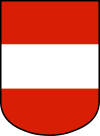Declaration of Neutrality
Part of a series on the |
|---|
| History of Austria |
 |
|
World War I |
|
World War II |
|
Post-war Austria |
|
Topics |
|
|
The Declaration of Neutrality was a declaration by the Austrian Parliament declaring the country permanently neutral. It was enacted on 26 October 1955 as a constitutional act of parliament, i.e., as part of the Constitution of Austria.
Formally, the declaration was promulgated voluntarily by the Republic of Austria. Politically, it was the direct consequence of the allied occupation by the Soviet Union, the United States, the United Kingdom, and France between 1945 and 1955, from which the country was freed by the Austrian State Treaty of 15 May the same year. The Soviet Union would not have agreed to the State Treaty if Austria had not committed herself to declare her neutrality after the allied forces had left the country.[1]
_1955_1151.jpg)
Since 1955,[2] neutrality has become a deeply ingrained element of Austrian identity. Austria's national holiday on 26 October commemorates the declaration. Legally, Austrian neutrality is both part of the Austrian constitution and of international law. There is an ongoing debate among legal scholars whether Austria could change this neutral status on its own account. This is a moot point, however, since there is no political or popular support for doing so.
Collaboration
Austria engages in UN-led peacekeeping and other humanitarian missions. It participates in:
- KFOR, with up to 561 soldiers. This mission is alongside NATO forces. Other countries in this mission include Switzerland, also famous for its neutrality.
- EUFOR (former SFOR) in Bosnia and Herzegovina, since 2 December 2004 under European Union Command
- United Nations Interim Force in Lebanon (UNIFIL) in Lebanon.
References
- ↑ K. Ginther, Neutralität und Neutralitätspolitik Die österreichische Neutralität zwischen Schweizer Muster und sowjetischer Koexistenzdoktrin, Vienna, 1975.
- ↑ Bundesgesetzblatt für die Republik Österreich, 1955, de:Datei:Bundesgesetzblatt (Austria) 1955 1151.jpg
- Rolf Steininger: Der Staatsvertrag. Österreich im Schatten von deutscher Frage und Kaltem Krieg 1938-1955, 2005, 198 p., (Publisher: StudienVerlag, Innsbruck-Wien-Bozen) - Summary in English
- Manfried Rauchensteiner: Stalinplatz 4. Österreich unter alliierter Besatzung, 2005, 336 p., (Publisher: Edition Steinbauer, Wien)
- The Federal Constitutional Law on the Neutrality of Austria in English